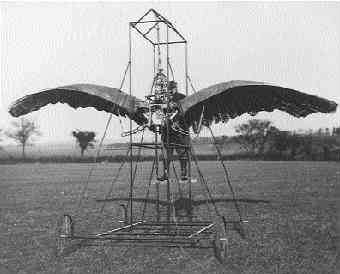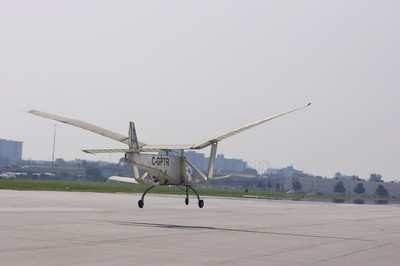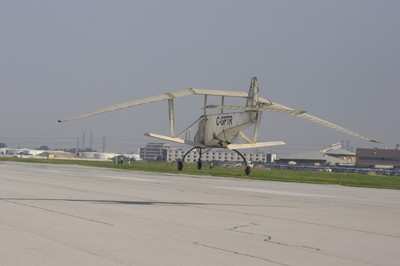'Flapper' Lifts Off For 14 Seconds
An alert ANN News-Spy called our attention to a rather
remarkable achievement recently up north: the successful, sustained
flight of a real-life, manned "ornithopter" -- a design steeped in
mystery, that originated on the drawing board of one Leonardo da
Vinci.

Perhaps you've heard of him.
The Toronto Star reports Dr. James DeLaurier, an aeronautical
engineer and professor emeritus at the University of Toronto's
Institute for Aerospace Studies, witnessed the first successful
flight of his manned ornithopter design July 8 -- if only for 14
seconds, after which time a gusty crosswind brought the contraption
down in a hard landing. But it was enough, DeLaurier said, just
seeing his design take flight.
"It is a perfect day," he said after the flight. "If I have the
big one now, I'll die happy."

But what, exactly, is an ornithopter? As the name implies, its
design is rooted in avian world -- a vessel that achieves flight by
mimicking the flapping movements of a bird's wings (its name
derives from the Greek ornithos, or "bird" and pteron, "wing".) Da
Vinci first dreamed up the design in the late 15th century -- and
while many tried to take flight in ornithopters in the centuries
leading up the Wright Brothers' first flight of a far more
conventional bird in 1903, very few have been able to succeed.
What makes DeLaurier's achievement notable, in particular, is
that last Saturday's flight is believed to be the first confirmed
example of an ornithopter taking flight, completely under its own
power -- in this case, by a 60-lbs thrust model jet engine.
Previous confirmed flights have been made in contraptions that
either glided down from a higher place, or were towed into the
air*.
"You did it man," DeLaurier told pilot Jack Sanderson. "You've
made an old professor really happy. You've made aviation
history."
DeLaurier has worked with ornithopters since he was a teenager,
building rubber-band-powered models out of balsa wood. He says he
got serious in 1973, when he teamed up with a fellow colleague,
Jeremy Harris, who shared his enthusiasm with ornithopters.
The two men experimented with several designs, before
successfully flying a remote-controlled ornithopter -- called "Mr.
Bill" (oh no!) -- in 1991. A successor model is now displayed at
the Museum of Science and Industry in Chicago, IL.
Despite the team's success, DeLaurier writes on the project
website that the flight wasn't a true example of an ornithopter...
at least in the da Vinci vein.

"The important thing to remember is that the aircraft needed jet
power to stay aloft. It wasn't a pure flapping-wing flight,"
DeLaurier says. "...Of course, in all fairness I should say that
the jet alone could not have even come close to sustaining the
aircraft; the flapping still did most of the work."
"So, we can say it was a jet-assisted ornithopter that sustained
level flight."
Which is, of course, still a pretty remarkable achievement.
* Note -- There are unconfirmed reports of
earlier, powered, manned ornithopter flights, as well -- going back
as early as 1781, when Karl Friederich Meerwein reportedly flew a
powered ornithopter in Germany. More recently, Adalbert Schmid made
powered flights in a motorized, manned ornithopter in 1942 -- and a
Russian team, led by Vladimir Toporov, built a tow-launched,
human-powered ornithopter that could reportedly climb under
power in the early 1990s.
And then there's the mythical tale of Daedalus and
Icarus... but that's another story.
 Unfortunate... ANN/SportPlane Resource Guide Adds To Cautionary Advisories
Unfortunate... ANN/SportPlane Resource Guide Adds To Cautionary Advisories ANN FAQ: Turn On Post Notifications
ANN FAQ: Turn On Post Notifications ANN's Daily Aero-Term (04.29.24): Visual Approach Slope Indicator (VASI)
ANN's Daily Aero-Term (04.29.24): Visual Approach Slope Indicator (VASI) ANN's Daily Aero-Term (04.28.24): Airport Marking Aids
ANN's Daily Aero-Term (04.28.24): Airport Marking Aids ANN's Daily Aero-Linx (04.28.24)
ANN's Daily Aero-Linx (04.28.24)





